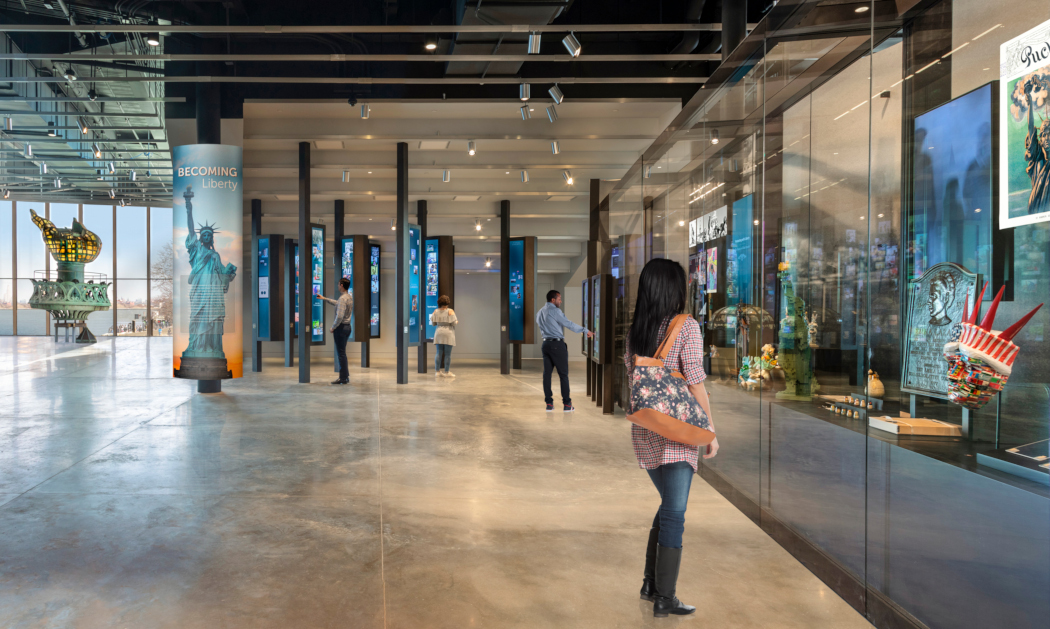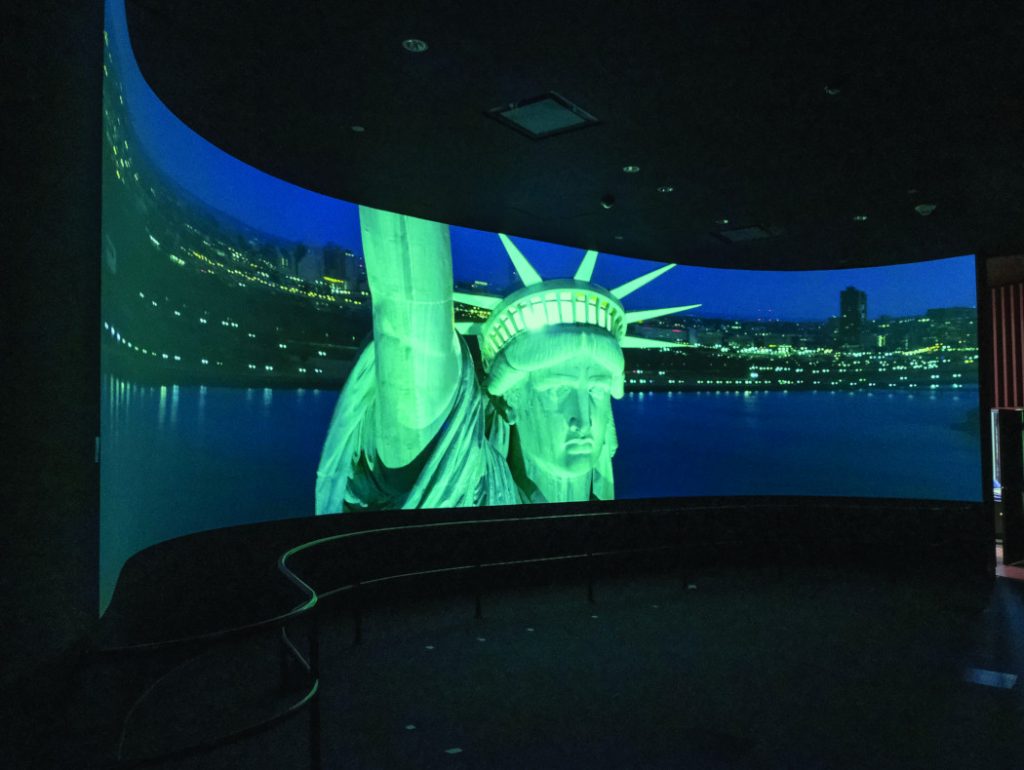Five years and $100 million in the making is the new, 26,000-square-foot Statue of Liberty Museum. That the new museum is tied to the single most iconic symbol of immigration in United States history makes its mission all the more challenging at the moment. The self-standing museum’s designers relied heavily on AV technology to help them tell a uniquely, singularly American story.
Inside, three main gallery spaces create a flowing narration. It starts with the Immersive Theater, a stand-up cinema in which videos describe the statue’s origins and its journey to New York Harbor. Then, it’s on to a gallery on the building of the statue, with exhibits illuminating sculptor Frederic-Auguste Bartholdi’s studio, the models and molds used to make the statue, and a replica of its foot; there are also explanations of how iconic the statue has come to be, with items like a menorah on which each candle holder is a small Lady Liberty, as well as comic-book art, license plates and dolls. In the final section, visitors, using interactive touchscreen kiosks, are encouraged to take digital self-portraits and add their thoughts on what liberty means to them.
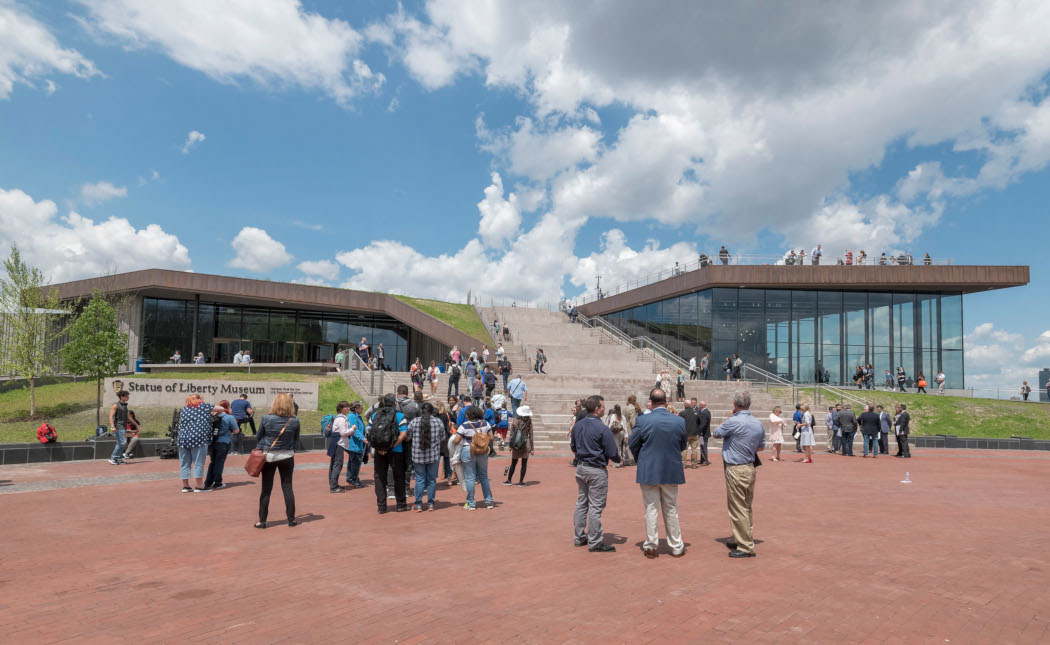
Well-known AV integrator Diversified was brought onto the project by ESI Design, the experience-design firm behind the new museum’s exhibits, as its technology partner; later, the firm contracted directly with the Statue of Liberty-Ellis Island Foundation (SOLEIF) as the AV integrator. (What made this project different from most was that everyone on the job could trace their family back to a generation that sailed past Liberty Island, and likely even stopped at the nearby Ellis Island immigration-processing center.)
A core starting point was to give each of the three abovementioned areas, as well as the Donor Wall located outside the Immersive Theater, a high degree of technical autonomy, even as their messaging was connected. “Each area of the museum is equipped with its own self-contained systems, built with extensive redundancies, meaning each area can operate independently and continue to operate normally in the event there is a problem in another area,” Carol Feeley-Vario, Diversified’s Project Manager, said. A second-generation American, with family roots in Germany, Lithuania, Italy and Ireland, she added that operational economies were also part of the plan. “The technology platform is based on digital, solid-state components wherever possible, and all displays use laser-phosphor or LED light engines, eliminating the need ever to replace a lamp. The platform is controlled through a dedicated, segregated AV-system network, including all necessary switches, cabling and other hardware. And everything is designed [to guard against] a potential failover, because, after all, this is an island.”
(The attention to costs is part of a much older and very grassroots theme around the statue. The new museum was funded mainly through small-dollar individual donors, with $35 being the average gift amount; Liberty Mutual Insurance, which features the statue prominently in its television commercials, made the largest single donation of $5 million. That’s not unlike how the pedestal itself was paid for in 1885, drawing from donations from more than 160,000 donors, including young children, businessmen, street cleaners and politicians. In fact, more than three-quarters of the donations amounted to less than a dollar. The original crowdfunding moment, as it were.)
Dedicated AV Network
In each exhibit, both audio and video content play out from server-class computers that each include at least one backup playout server. The video outputs of all servers are via video-over-IP over a dedicated AV network; the audio-distribution system is fully redundant, and it runs over a dedicated digital audio network. Additionally, audio is driven to the speakers through dedicated amplifiers with at least one backup amplifier in each system. The master and audio control systems continually monitor the status and operation of every audio and video server, and, when necessary, they’ll trigger an automatic switch over to the backup servers.
Getting the Statue of Liberty’s new museum together through New York Harbor was, in some ways, nearly as challenging as it was for some of the team’s grandparents to cross the Atlantic Ocean. “The logistics were the first and most enduring challenges,” Feeley-Vario affirmed, citing in particular the task of getting a 43’x11′ videowall onto a barge and into the new building through a temporary construction dock established on the island. And, if that wasn’t complicated enough, the dock had to be removed before a protected species of perch began spawning in the Hudson River, or else it would be stuck there through the following spring. But the AV logistics were relatively easy as compared to the challenges that the general contractors had to manage.
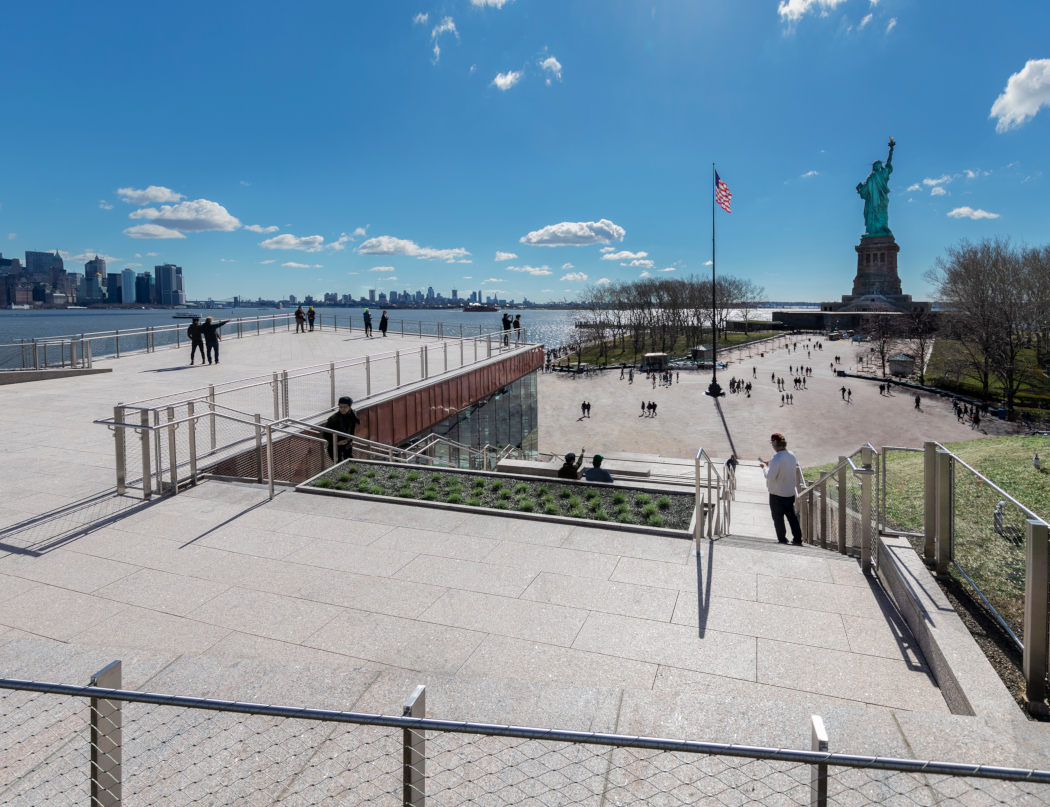
One AV challenge was the speed with which product models changed during the project’s timeline, creating ongoing variations in the equipment lists. Mark DiQuinzio (a second-generation American—Abruzzo, Italy), Diversified’s Lead Engineer, noted that, when the project’s technology was first being specified, the control system was going to be based on generic HDBaseT; that is, until Crestron’s NVX became available. “That literally didn’t exist when we were planning this in 2016,” DiQuinzio said. “When it became available, we switched it out as a value-engineering move and took the savings and applied them toward upgrading the Panasonic 4K projector in the middle lobe of the Immersive Theater, [going] from 12,000 lumens to 20,000 lumens. And that newer projector came here literally right off the assembly line. Things change faster than ever now, so we have to learn how to leverage that.”
Step Inside
Viewed from the outside, the glass walls and copper-hued roof of the Statue of Liberty Museum seem like an organic extension of the land around it. The museum structure is meant to connect to Lady Liberty, using the same granite that’s part of the statue pedestal and the statue’s copper cladding.
The first stop inside for visitors is the Immersive Theater, a kind of informational triplex; there are three areas, each playing distinct content on deeply curved Novawall screens through a combination of eight Panasonic laser-phosphor projectors and a proprietary media player supplied by Float4, the content designer. The images in each area are created by overlapping and blending multiple projections. BrightSign media players are also used to provide static images between video loops. (Donna Lawrence\ Productions produced the videos, as well as their audio.)
The Crestron CP3N control system for the theater allows the content in each area to be repeated in a regular loop. The content in the second and third area is timed so that each loop starts slightly after the finish of the loop in the previous area. The control system also raises the lighting in each area as the content loop finishes, which is also timed with the video and audio content; this encourages patrons to move on to the next screen. Although an operator will be able to start and stop each loop independently, the system will allow the preset sequence of loops to continue to run, with no intervention, throughout the day.
DiQuinzio said the projection screens presented the main visual challenges in this space. “We were originally going to paint the drywall with screen material, until our acoustical consultant, Steve Haas, recommended using speakers behind the screens in addition to the floor-mounted speakers,” he explained. “We then looked at perforated cinema screens, but realized we weren’t going to get a 43-foot screen that could make the turns these had to make. The fabricator, Maltbie, suggested the Novawall stretch material, which they had used successfully in previous museum installations.”
It worked well for this application too, although not without a little help. Steven Esposito, Diversified’s Project Engineer (a second-generation American—Italy), noted that several seams were noticeable when the material was illuminated by the projectors. So, Panasonic engineers helped by applying the projectors’ warp engine and software to map around the seams. “It required a lot of mapping,” he explained, “but, in the end, it looked great. Panasonic was a huge help to us through the project.”
The audio in each theater area is also immersive, playing out through six or seven JBL Control 25AV speakers, depending on the size of the area, along with two Bag End custom-shaped 10-inch subs for each screen. The audio playback in each theater is reproduced through a sound system that Haas, of SH Acoustics, designed. Two speakers and subwoofers placed behind each screen are complemented by an array of compact speakers firing upward through floor grilles under the audience.
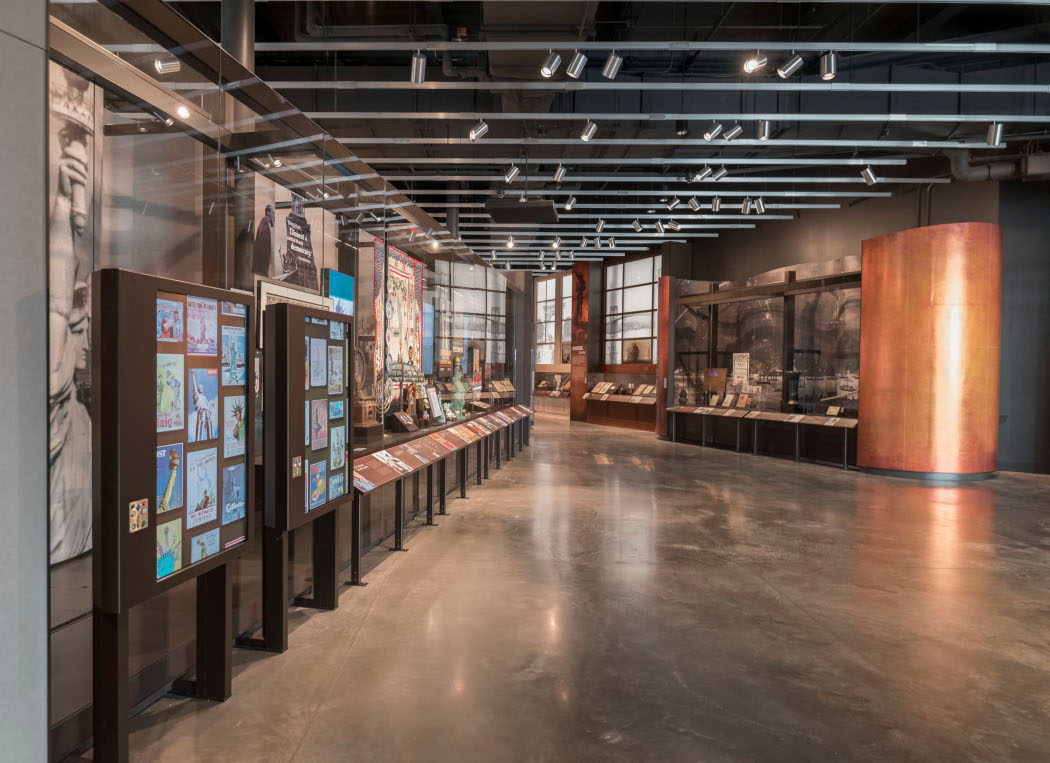
“We worked closely with the media producers for this project, as we always do, but this was different,” Haas (a second-generation American—Germany and Hungary) revealed. “It wasn’t the largest museum we’ve ever worked on, but it was one of the biggest in terms of throughput of visitors. So, keeping the sound [in] each area of the multi-zone theater separate was paramount, [but we also had to maintain] a high degree of immersiveness in each lobe of the theater.”
That immersiveness is achieved through a combination of directional speaker placement on a grid underneath the theater floors in front of the screens. That, Haas said, sufficiently localizes the sound to each theater area and distinguishes the upward-moving effects sound, which are delayed to match the arrival of sound from the ear-level speakers behind the screens. Those reproduce most of the dialogue, and they’re set at a 100-degree angle for optimal dispersion over the 30 to 50 people each lobe comfortably holds, without interfering with adjacent viewing areas. This configuration also keeps the sound focused on each area, creating a transitional portal between theater lobes as prompts from the Crestron automation system help move the crowds along.
Finally, the theater areas are treated with absorptive material on the walls and ceiling, which also help hide the wall-mounted subwoofers. Three global volume settings—one for three possible crowd sizes—are loaded into the QSC audio processor for the Q-SYS network that moves sound around the venue. The Crestron system activates this capability, as the visitor tide ebbs and flows during the day.
The Donor Wall, a transitional point ahead of the Immersive Theater, includes a total of five Elo 22-inch touchscreen displays, driven by Seneca NUC media players that run custom software. (As backups, there are also BrightSign players.) These show information about selected donors to the museum. Underscoring the project’s time span, the Samsung touchscreens originally specified had gone out of production by the time installation was scheduled.
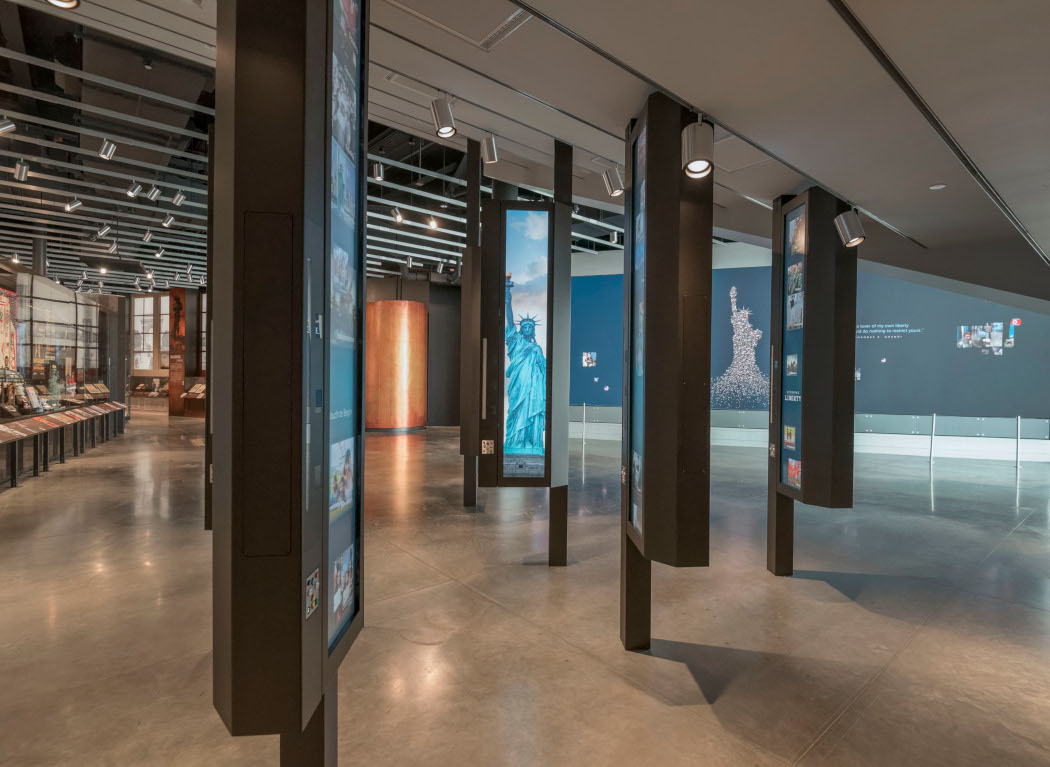
Twenty interactive kiosks attached to either side of 10 stands allow visitors to insert themselves virtually into a media presentation along a 43-foot LED wall. Courtesy Kevin Daley, National Parks Service.
Engaging The Audience
The Engagement Gallery, the next set of exhibits, is where visitors can get hands-on with historical information on topics that include fundraising, envisioning the sculpture and how the Statue of Liberty has influenced culture. There’s even an opportunity to look at sculptor Frederic-Auguste Bartholdi’s sketchbook. Displays throughout this gallery play continuous video and audio loops.
The first section of the Engagement Gallery is the “Constructing Liberty” area, which is built around four fixed graphic walls with overlaid, projected video images from four Panasonic 6,500-lumen projectors. Different sections of the walls are highlighted and complemented with explanatory text. In front of the walls are three smaller Planar video display panels that cycle through additional information. A single multi-output video server feeds the projectors in this area; an additional server with the same number of outputs serves as the backup. Each flatpanel display is fed by a single-output BrightSign XD1033 digital video player; there is a backup player for each.
An issue that museums face today is how to integrate actual physical artifacts with digital ones—for instance, an actual period letter versus a scan. Although that might be largely a historical and an aesthetic concern, it also can be an AV issue. Feeley-Vario pointed out that the heat generated by AV systems in close proximity to physical artifacts could result in accelerated deterioration or damage to those artifacts.
Feeley-Vario explained, “We worked with the National Parks Service preservationist to determine how best to keep heat away from the artifacts that were in climate-controlled cases” when the artifacts themselves and informative digital signage about them were sharing spaces. Esposito was tasked with checking the manufacturers’ spec sheets on the projectors and other devices for their heat output; when those data weren’t available, he said, he calculated the values himself by extrapolating them from voltage and amperage information in the device manuals. “The preservationist gave us the temperature ranges and we worked from there,” he explained. “Each display case is sort of its own little building.”
The project required some fairly unique pieces of equipment. For instance, the “Pedestal & Fundraising” section of the Engagement Gallery required video displays that could go transparent when not showing content. Fifty-five-inch transparent LCD screens made by a UK-based company, Crystal Display Systems (CDS), were sourced. Also, environmental-soundscape playback around some of the exhibit galleries uses Acoustic Enhancements transducers attached to drywall or plywood backing so that sound literally comes out of the exhibit walls and display cases. In those cases, every outcome was unique. “Not every surface sounds great right out of the box for this type of application,” Haas remarked. “So, we had to test a few different materials, and we’ve gotten very good at EQ-ing them.”
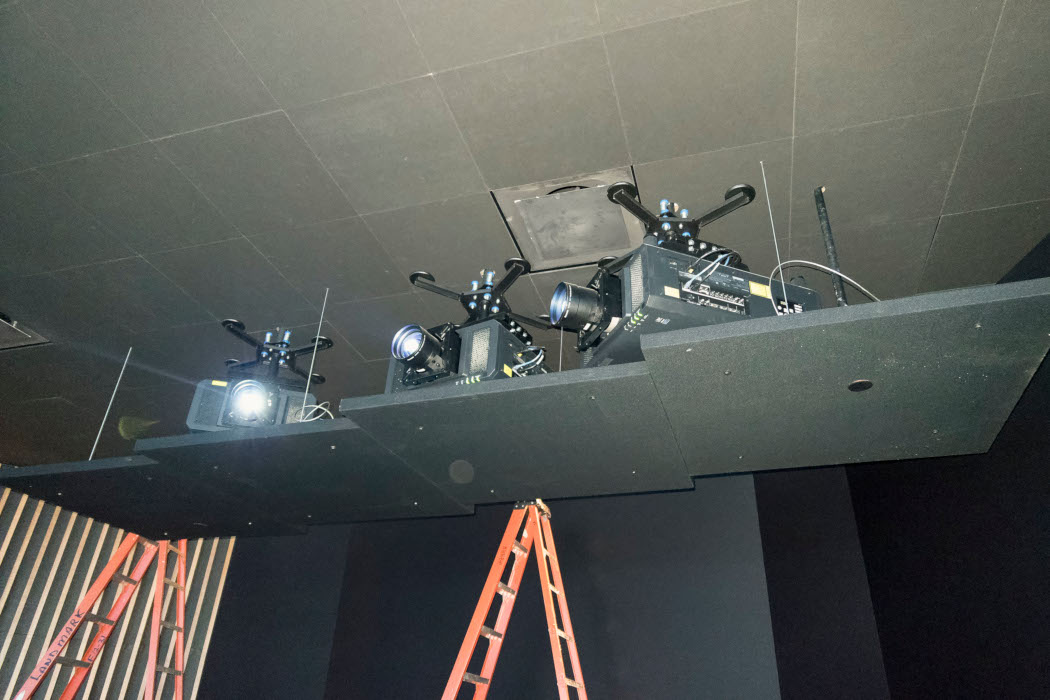
The last stop in this area, “Becoming Liberty,” is the most complex: a 43’x12′ 1.5mm LED wall, brought in via barge, pairs with 20 interactive touchscreen kiosks attached to either side of 10 stands. The Unilumin wall (partially donated by the company) and its rear-serviceable, 20×10 cabinet configuration is supported by an RPV floor mount and fed by three BrightSign media players. It’s surrounded by a combination of JBL Control 25 speakers, three CBT100LA columnar arrays and three Innovox Microsub6 subwoofers, powered by six QSX CX203 amplifiers.
DiQuinzio revealed that the wall wasn’t even part of the original plan. As it happened, the Foundation decided to remove a gift shop that had been planned for that space. That created an opportunity for more storytelling, and the Diversified team went through a list of possibilities before deciding on the 1.5mm LED (7,680×2,160 pixels) videowall. Better still, Unilumin’s donation brought the videowall within budget. “The process of creating and installing it went on while the general contractor was still constructing the building,” DiQuinzio commented. “We had to ask for a lot of extra cooling for it.” With a laugh, he quipped, “It didn’t make us a lot of friends with the contractors!”
ESI Design, the Manhattan-based firm that designed the new museum’s content and visitor experience (the Brooklyn Children’s Museum is also in its portfolio), worked closely with Diversified from the systems-design phase of the project. Offering an example of how content and technology can interact on complex projects like this, Charles Deluga, a Designer and AV Technologist at ESI Design, noted that the original specification for the “Becoming Liberty” wall called for front projection. Concern about how ambient light in the area might affect the installation’s impact, however, led the ESI team to bring the matter up to Diversified’s designers; they then suggested using rear projection. Ultimately, the matter was resolved when the Unilumin option became available and practicable.
“We always want to make sure that the design’s intent is carried out the way we envisioned it,” Deluga said. “Sometimes, decisions have to be made based on changes in budget or how construction takes place, but we always want to find a way to make sure the original design intent is carried out.”
The two-sided kiosks have 86-inch, ultra-HD LG 86BH5C (3,840×600 pixels) displays on each side, connected to a local mini PC. Patrons can create their own content on any one of the displays, including taking a photo from one of the three Logitech 4K Pro USB PTZ cameras mounted to the left of each display. The three cameras are set at different heights to accommodate varying visitor heights, ensuring compliance with federal Americans with Disabilities Act (ADA) regulations. Once a patron has completed his or her input, he or she can send it to the LED wall over the AV network to a set of content playout computers that ingest the local content, overlay it on background video and distribute the total image out to the large LED videowall. There, it “travels” the length of the wall.
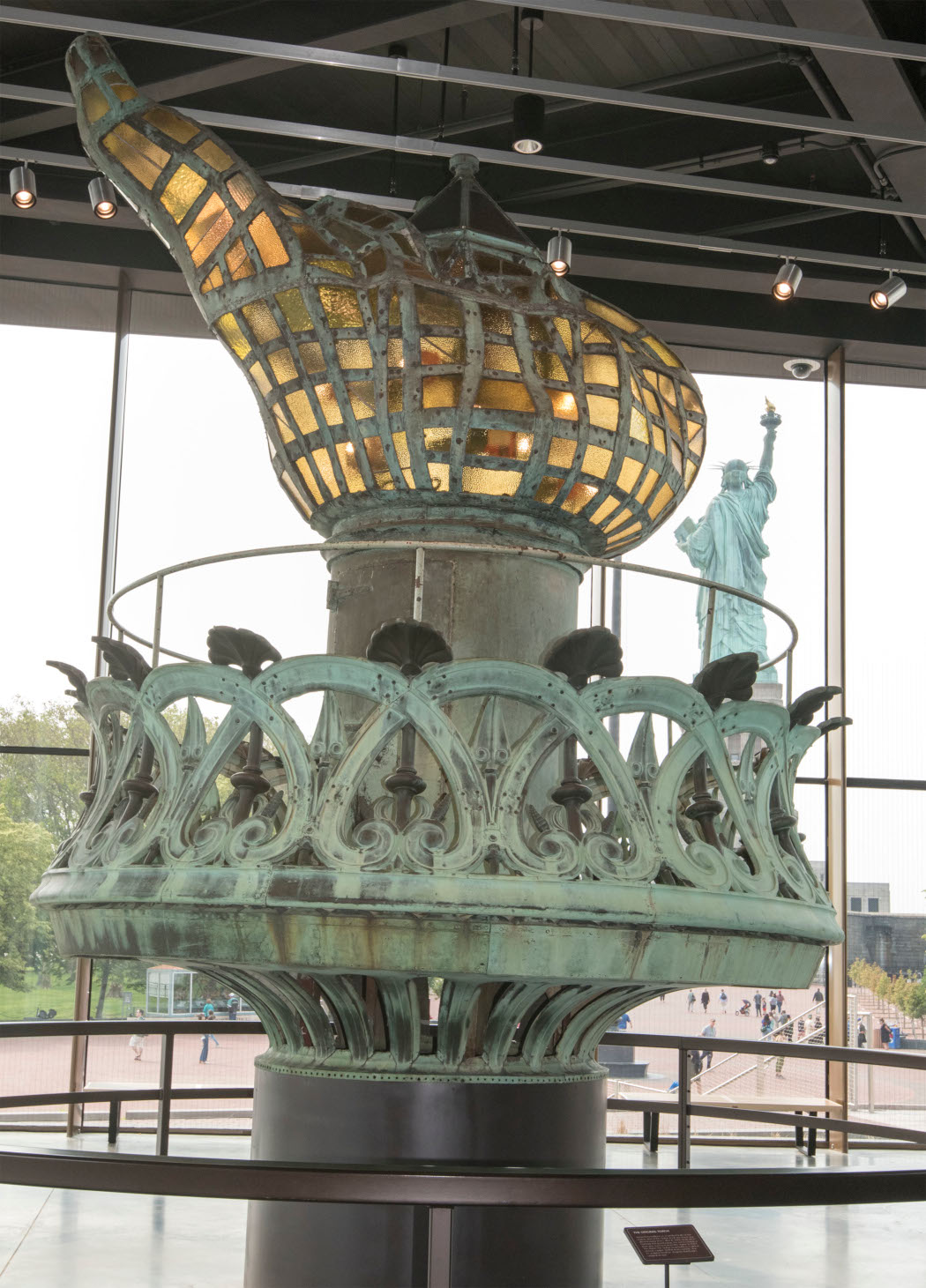
Here, the challenge was getting all the necessary technology into the kiosks, Feeley-Vario revealed. Citing the large size of the displays, she said the project team chose to use an infrared (IR) overlay on the screen glass. However, due to the frequency and force of the touches the screens would have to endure, they needed to physically buffer between the display and the overlay, using quarter-inch-thick glass. A thin, conductive, acrylic strip was also added to cover the space between the frame and the IR overlay; this helped avoid having a gap large enough where debris could enter and interfere with the IR function. “LG was the only manufacturer that made these sized screens, but they weren’t touchscreens,” DiQuinzio added. “So, we improvised.”
The densely packed kiosks underscore the museum’s infrastructure in general. Feeley-Vario noted that the venue’s heating, ventilation and air conditioning (HVAC) could have to accommodate as many as 400 visitors in the museum at the same time; this resulted in a lot of ductwork, leading inexorably to “a lot of cabling [and] a lot of conduit, which we had to work around,” she said. She added that there are virtually no 90-degree angles in the entire venue, meaning most of the cabling has to navigate curving walls. “It reminded us why we paid attention in school during math,” she quipped. Most of the infrastructure uses copper cabling between the exhibits and the two rack rooms, since those runs are less than 100m. The two rack rooms themselves, which are filled with a combined 13 Middle Atlantic rack units, are connected to each other over the Q-SYS network by fiber.
The Statue of Liberty Museum comes at a pivotal moment in time, when the very peregrinations it celebrates are taking place again, albeit under different circumstances, but in search of the same ends: a chance to start over in a new land. Each of the AV team members went into this project with his or her own immigrant legacy, and each came out of the experience having become more aware of it. And, just as the statue has always done, it presided over yet another generation being “delivered” to America: Three babies were born to team-member families during the years-long integration process, including Feeley-Vario’s son, born this past September. A fourth—the first child for Diversified Account Manager Rudy De La Uz—is on the way.
As John Mellencamp would say, “But ain’t that America.”
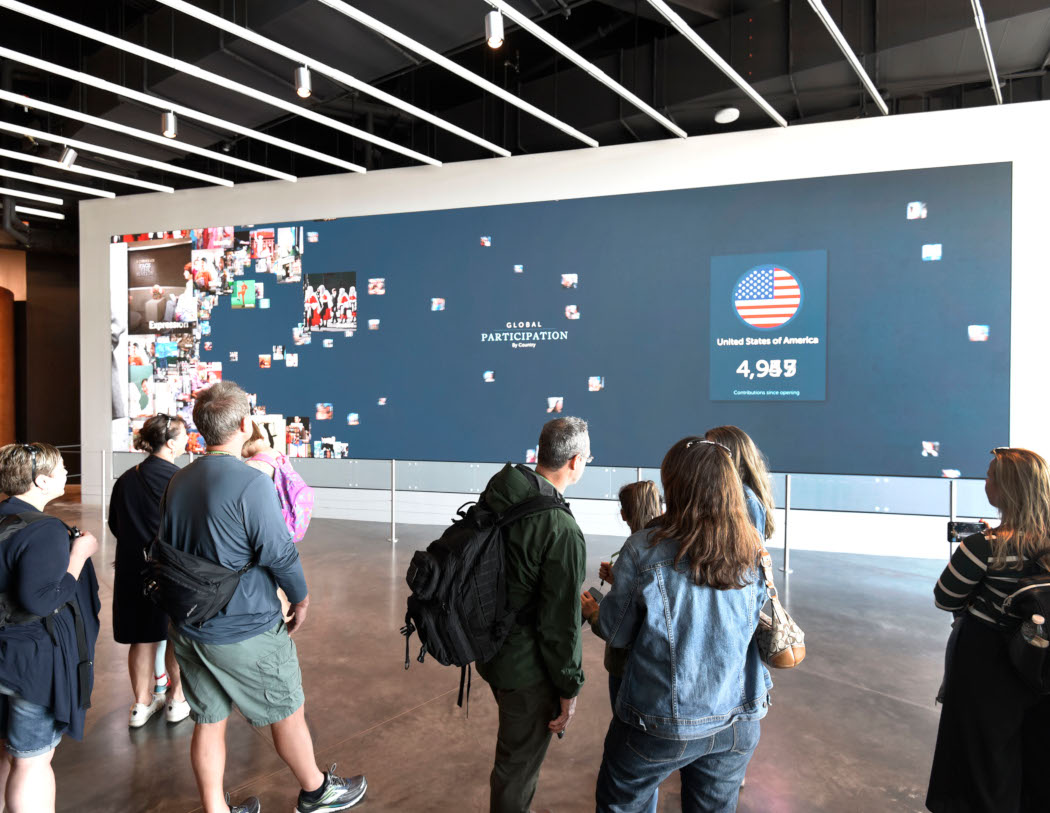
Sound Design Meets Sound Systems
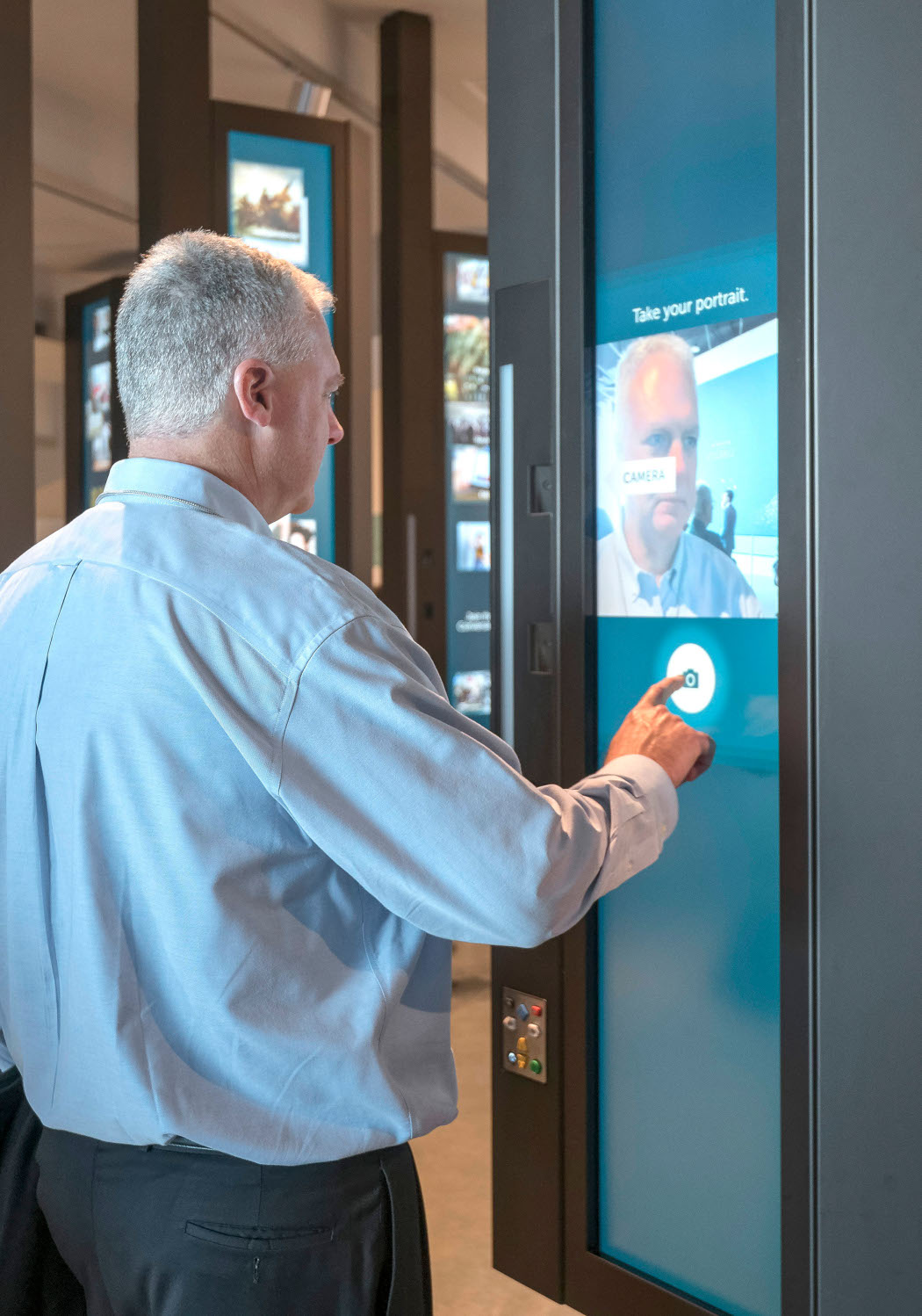
The sound design for the Engagement Gallery is both technically adroit and historically accurate. Sound designer Jeremy Bloom, whose work is heard in films, podcasts, theatrical shows and museums, including New York’s Tenement Museum, went so far as to bring a field recorder to the Paterson NJ-based metalworks firm that worked on the statue’s 1984 restoration project. With it, he captured the authentic sounds of copper being hammered onto the actual molds used to make the statue.
Bloom said the playback system for the soundscapes had been largely specified before he became involved. “But it was designed in such a way as to be very flexible, so it could support a wide range of audio elements,” he commented, adding that the Q-SYS DSP also added flexibility in areas such as equalization and complex routing.
The soundscapes were recorded in a New York NY post facility and mixed through Dolby’s object-based Atmos immersive sound platform to create a pre-installation mock-up of the playback configuration. Several dozen sound files of stems from those mixes were then loaded as .wav files onto the Q-SYS system, and they’re played back through a matrix that focuses the appropriate suite of stems on a particular part of the exhibit through its particular assortment of transducers. For instance, the “Constructing Liberty” exhibit area uses four separate channels in a semi-circular layout, whereas “Opening Ceremony” has five separate channels spread linearly across a wall.
There is a certain amount of overlap between galleries to suggest continuity, with highly precise timing of key elements within the mixes to reinforce immersiveness. For instance, oral histories from one gallery are punctuated by cannon shots from another gallery. “There’s some overlap between galleries, but the sound effects never interrupt the voices in the other,” Bloom explained. The seamlessness of the soundscapes is further enhanced by the fact that all the music used to underscore them is in the same key; meanwhile, the tempos, although they do vary, are always in beats-per-minute (BPM) values that are divisible by each other. The effect, he explained, is analogous to a DJ moving the fader between turntables. “The audience, as they move between galleries, is creating their own seamless crossfades,” he noted.
